Up until about ten years ago, it was extremely unfashionable to be a geek. Geeks were considered the black swans of the social world: they were perceived as having limited social skills, little interest in non-programming activities, and few friends.
Fast forward to today, and things have changed significantly for the geek. Geeks today run the coolest companies, create the most cutting-edge trends, and are popular guests on the social circuit. And as the geek has evolved, so too has his or her skills: today's geeks are not just clever programmers, but they also know how to finance and market their products.
If you're a geek with an open source product, then you should know that every open source business ecosystem offers multiple revenue opportunities for you to exploit. However, doing this successfully requires an understanding of business dynamics within these ecosystems, so that you can use open source marketing to raise your credibility and generate sales for your product.
Understanding open source business ecosystems
As a necessary first step, it's important to understand the business ecosystem in which your product will exist. Ecosystems may be classified as vendor-driven, community-driven or consortium-driven:
- Community-driven ecosystems are decentralized and characterized by a vibrant developer community, extensive Q&A and active word-of-mouth marketing. They usually don't have a single major vendor or obvious choices for enterprise-level support. Examples of this structure are the Drupal, Joomla! and Plone ecosystems.
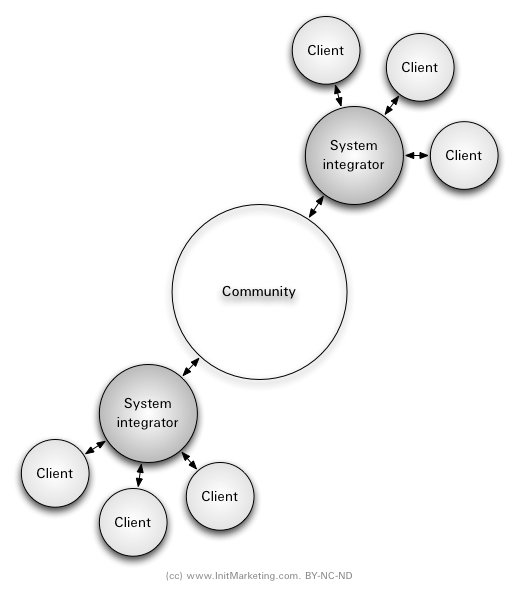
- Vendor-driven ecosystems are highly centralized and revolve around a single vendor. Other actors in the ecosystem, such as system integrators, customers and partners, exhibit a high degree of dependence on the vendor. The MySQL ecosystem is an example of this.
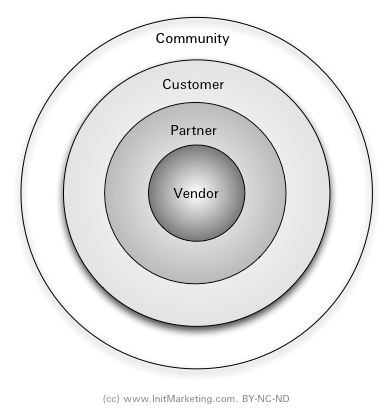
- Consortium-driven ecosystems are similar to community-driven ecosystems, but have a more formal governance structure wherein a consortium governs the ecosystem. Typically, a consortium comprises key members and contributors, either from commercial or non-profit organizations or being individuals. Consortium members are elected or appointed according to a binding bylaw. A good example here is the Eclipse Foundation.
The nature of the ecosystem is important because it defines the relationships between the key actors, such as partners, system integrators, consultants and community members, and the degrees of freedom they have. For example, in a vendor-driven ecosystem, the vendor-centric nature of the ecosystem allows the vendor to exert a high level of control over ecosystem entry and exit, rights and privileges of actors, and monitoring. By contrast, in a community-driven ecosystem, actors have greater freedom of action, can enter and exit at will, and are subject to limited oversight. This in turn impacts the nature of each actor's business model.
Identifying actors and marketplace conversations
Looking at the three types of ecosystems, it's fairly easy to identify some common actors and relationships:
- Community members contribute to and maintain community assets, such as source code, documentation, Web sites and so on.
- Vendors use community assets to provide software products, services or a combination of both.
- Partners, such as system integrators or creative agencies, work closely with vendors to resell or supplement vendor offerings, either "as is" or by bundling them with other products or value-added services.
- Customers purchase product and services from partners.
- "Lone wolf" consultants work independently, implementing customer projects on their own or working with partners as subcontractors.
"Markets are conversations", says The Cluetrain Manifesto, and it's important to remember that the above actors are neither static nor silent. Rather, they're communicating with each other constantly to share and information, referrals and community assets. Consider the next picture, which illustrates some of the typical conversations occurring within the community:
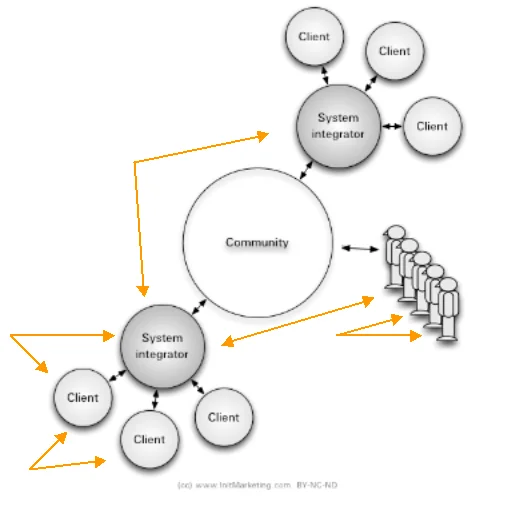
- Community members communicate with each other (eg: to share information and knowledge)
- Partners communicate with each other (eg: to subcontract work or share leads)
- Partners communicate with clients (eg: to send proposals or implement projects)
- Partners communicate with community members (eg: to obtain technical assistance or subcontract work)
- Clients communicate with each other (eg: to obtain referrals)
In addition to all these intra-community conversations, there also exist other conversations taking place between the community and the wider world through channels such as press, trade fairs, workshops, conferences and social media.
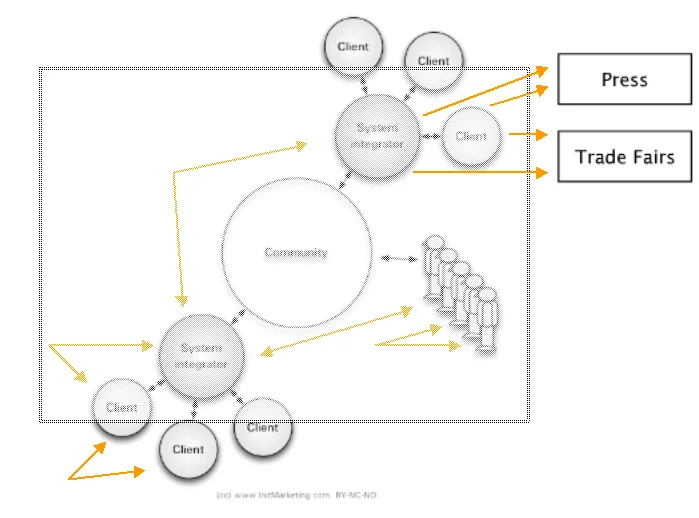
- Community members use these channels to disseminate news and promote community goals
- Partners use these channels to advertise their skills to potential clients
- Clients use these channels to search for suitable partners
The strategic implication here should be clear: to become visible in the marketplace, you must first join in the conversation.And that's where marketing can help.
Crossing the moore chasm
In his book Crossing the Chasm, Geoffrey Moore argues that there exists a chasm between the early adopters of a product or service and the vast majority of users. This chasm is visible in Moore's famous adaptation of the technology adoption lifecycle diagram, illustrated below:
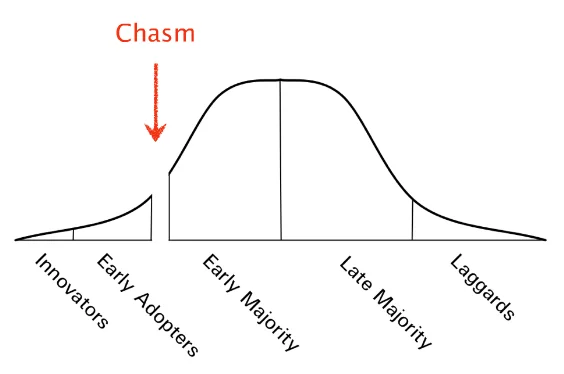
For a firm to become successful, it must find a way to "cross the chasm" and expand its product or service offering to the large majority of users. If a firm fails to do this, its user base will remain constrained to a niche audience, and it will never enter the mainstream marketplace or attract the attention of the wider community of users.
How open source marketing can help
Marketing has an integral role to play in helping your firm cross the chasm because it can help you join marketplace conversations and, through these conversations, raise awareness about your firm and your product offering. This helps potential customers understand the business and technical benefits of your product, and increases the probability of a marketplace match.
In an open source ecosystem, where information flows swiftly and freely, marketing can have an even greater effect on your fortunes. The role of marketing in open source ecosystems is not so much that of a gatekeeper, but rather that of a facilitator, which initiates information flow through marketplace conversation, reinforces it with marketing collaterals and reputation, and (eventually) produces solid leads and sales.
Raise awareness and credibility
You can raise your credibility in the marketplace by actively participating in marketplace conversations, thereby raising awareness of your presence and your product or service offerings.
Within the community, a cost-effective way to perform this type of marketing is by asking and answering questions in community fora such as mailing lists, wikis and discussion groups. So-called word-of-mouth marketing (WOMM) can be wonderfully implemented here, especially with social media tools like Twitter, Weblogs, etc. Thus, for example, a new module will, with little effort, quickly become known within the community.
Raising awareness outside the community requires a little more time, money and marketing know-how. Organizing events such as conferences and workshops, participating in trade fairs, sending out direct marketing, and advertising are typical marketing activities that you can undertake to raise your profile outside the community and build credibility with potential customers who may not be directly involved in the community.
Improve marketing communication
The end goal of any marketing activity is the generation of leads (and eventually, sales) through effective communication of a firm's product or service offering. As a geek, you probably understand and can communicate with the open source developer community very well. However, to present your product or service to the wider marketplace, you'll also need to learn to communicate with the press, with partners, and with potential customers, and to present the business benefits of your product or service in clear, concise and non-technical terms.
An effective way to do this is through the development of marketing collaterals, such as case studies, white papers and brochures. These collaterals enable you to communicate the key features and benefits of your product or service, and are specifically targeted to different audience segments—for example, a technical white paper for system administrators and a case study for CTOs.
Partners, in particular, are a good source of case studies, and using partner case studies creates a classic win-win situation: partners receive automatic marketing and credibility by virtue of their association with the vendor and the subject of the case study, and vendors can highlight the versatility of their Open Source product in different business scenarios.
Improving the overall quality and consistency of marketing communication is an added benefit of creating these collaterals. This ensures that customers and partners see a consistent brand identity and messaging, and that communication is uniform across all channels, be it press coverage, weblogs, Websites or advertising.
Shorten the sales cycle
A key component of open source marketing is information. It’s good marketing strategy to gives customers the maximum available information about an open source product. Case studies, white papers, screencasts, walkthroughs and online demos ensure that customers have every opportunity to validate and test the product against their own requirements and infrastructure before committing to a purchase.
Case study: Joom!Fish
The ability of open source marketing to help a firm build a marketplace presence is best illustrated through an example. Consider the case of Joom!Fish, an extension for the Joomla CMS that allows users to present a Web site in multiple languages. Joom!Fish is released under the GPL and is freely downloadable without any charge.
Business ecosystem
Joom!Fish is managed by an independent vendor, Think Network, which sells commercial support, additional documentation and special add-ons for Joom!Fish under a subscription model. This structure most closely resembles a vendor-driven ecosystem, with Think Network at the center and partners, integrators and community members coalescing around it. Although there are a large number of Joomla! extensions and modules, Joom!Fish is interesting, because Think Network has successful built a following around Joom!Fish through a "bottom up" open source marketing strategy.
Channels and market conversations
The natural offshoot of this is a significantly shorter sales cycle. When customers already have all the information they need to make a purchase decision, sales staff need to spend less time on handling pre-sales queries and qualifying leads. Customer self-qualify themselves for a product, and then contact the vendor only to consummate the sale. This reduces the overall time and effort needed to close a sale, and makes the entire sales cycle more efficient and respectful to all parties.
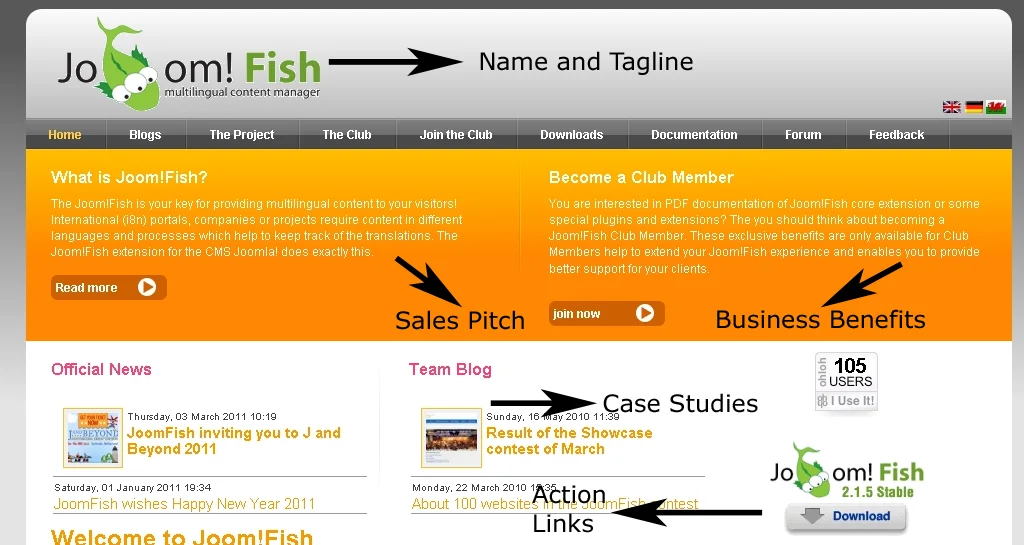
To illustrate, consider that the primary communication channel for any open source product is its Web site. Joom!Fish gets most of this right from the start. The product has a unique, easy-to-remember name that links it with the larger Joomla! ecosystem, and the product tagline of "multi-lingual content manager" is a concise soundbite that clearly expresses its purpose. The Web site defines the product's goals, identifies the business benefits of the commercial subscription service, and offers users actionable links to purchase a subscription or download the product. A "showcase" of case studies illustrates Joom!Fish's usage in different business scenarios and helps to communicate the business benefits of the product clearly.
Joom!Fish has also been successful at leveraging other existing Joomla community channels for word-of-mouth marketing and awareness building. For example, Joom!Fish is also listed in the Joomla! Extensions Directory, which gives it automatic visibility among Joomla! users and developers. The founder of Think Network, Alex Kempkens, is an active Joomla! practitioner, author of Joomla! books and technical tutorials, and contributor to Joomla! conferences, forum discussions and groups. Through these activities, he has been able to join market conversations and raise Joom!Fish's visibility in the larger Joomla! ecosystem, without any investment in public relations or advertising.
Credibility, visibility and sales

The Joomla! community initially consisted only of innovators and early adopters, but has since grown to include the early majority and late majority. Today, Joomla! is a well-known mainstream CMS that successfully communicates its business benefits and is frequently used for medium and large implementations. Via Joomla!, Joom!Fish has "crossed the chasm" - by piggybacking on Joomla!'s success, Joom!Fish has been able to attract the attention of the late majority without needing to invest in expensive advertising or product commercials.
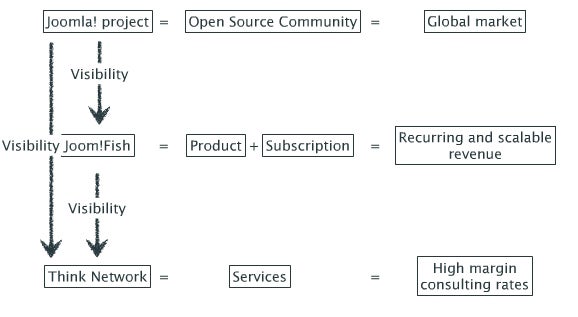
The Joomla! community is also a source of leads for Joom!Fish. Joom!Fish's business model is a subscription model. This subscription model ensures recurring and scalable revenue. Joom!Fish is also listed in the Joomla! Extensions Directory, accessed by users all over the world. This allows Joom!Fish access to a worldwide customer base without any additional cost. The success of Joom!Fish also raises the credibility of its vendor, Think Network, which is now perceived as an expert in Joomla! implementation; this allows it charge high-margin consulting rates to clients.
Conclusion
Achieving success with an open source product is not just about writing the best, most efficient code; it’s also about communicating the benefits of that product to the marketplace. An open source ecosystem is filled with conversations, and joining those conversations is the best way to get your product noticed, raise its credibility, and convert community users into qualified leads. As the Joom!Fish story illustrates, marketing tools and techniques can help take your product across the chasm, from a small base of early adopters to the much larger (and more profitable) late majority.






2 Comments